Smith & Wesson Model 29
| Smith & Wesson Model 29 | |
|---|---|
|
| |
| Type | Revolver |
| Place of origin | United States |
| Service history | |
| Used by | See Users |
| Production history | |
| Manufacturer | Smith & Wesson |
| Produced | 1955–Present |
| Specifications | |
| Weight |
|
| Barrel length |
|
|
| |
| Cartridge | |
| Caliber | .429 in (10.9 mm) |
| Action | Double-action |
| Feed system | Six round cylinder |
| Sights | Open, adjustable rear |
The Smith & Wesson Model 29 is a six-shot, double-action revolver chambered for the .44 Magnum cartridge and manufactured by the U.S. company Smith & Wesson.
The Model 29 was offered with 3", 4", 5", 6", 6½", 8⅜" and, later, 10⅝" barrel lengths as standard models. Other barrel lengths were available either by special order from Smith & Wesson's Custom Shop or custom built by gunsmiths. The 5" barreled variant had a full length underlug. Finish options available included a highly polished blued or nickel-plated surface.
History
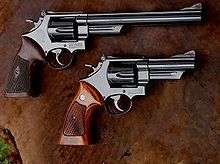
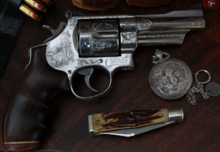
S&W's production of a large N-frame revolver in .44 Magnum began in 1955; the Model 29 designation was applied in 1957.[1] It remained primarily the province of handgun enthusiasts, some law enforcement personnel and hunters until 1971, when Clint Eastwood made it famous as "the most powerful handgun in the world" in the movie Dirty Harry. After the movie's release, retailers had trouble keeping the Model 29 in stock.[2]
At the time of its introduction, the Model 29 was the most powerful production handgun. There were a number of custom calibers that were more powerful, as in the old Howdah pistols of the 19th century. Elmer Keith's achievements in maximizing the power and performance of the .44 Special was the inspiration and driving force behind the introduction of the .44 Magnum by Smith & Wesson. His intention for the new round was for it to be used in sidearms for hunters of large, dangerous game, rather than for self-defense, though with today's specialty cartridges, it can be a good defensive round.[3]
The Model 29 will chamber and fire .44 Special cartridges, as the .44 Magnum was developed from the .44 Special. The Magnum case is slightly longer to prevent magnum rounds from being chambered and fired in handguns chambered for the .44 Special.
In the late 1990s, Smith & Wesson discontinued production of many models of revolvers, including the 'basic' Model 29; since then, at various times, the model, in limited or 'custom' configurations, has been manufactured in as many as 10 evolutions.[4]
Variants
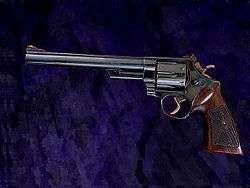
The original Model 29 was superseded by the Model 29-1 in 1960, with modifications made to the ejector-rod screw. The Model 29-2 replaced it the following year, with one screw that had secured the cylinder-stop spring being deleted. The barrel length was shortened from 6 1/2" to 6" in 1979. These two versions are known as "pinned and recessed". "Pinned" means that the barrels are screwed in, and secured by a pin driven through the frame and a notch in the barrel. "Recessed" denotes the rear of the bored cylinder holes being countersunk, so that, when loaded, the cartridge rims are fully enclosed by the cylinder. In 1982, the cost-cutting Model 29-3 dropped recessed cylinders and pinned barrels for crush-fit barrels.[1]
The -4 and -5, produced from 1988 and 1990 respectively had changes to improve durability for heavy use. In 1994 the 29-6 began production, now fitted as standard with rubber Monogrips from Hogue to replace the previous wooden items, standard tapped holes also being provided for attaching scope mounts. The 29-7 started production in 1998 with changes to the locking mechanism, the firing pin's attachment, and a hammer and trigger produced with a metal injection molding process.[1]
| Model | Start Year | Barrel Lengths | Modifications |
|---|---|---|---|
| 29 | 1957 | 6 1/2" | |
| 29-1 | 1960 | 6 1/2" | ejector rod screw |
| 29-2 | 1961 | 6 1/2" changed to 6" in 1979 | one screw that had secured the cylinder stop spring dropped |
| 29-3 | 1982 | dropped recessed cylinders and pinned barrels for crush-fit barrels | |
| 29-4 | 1988 | ||
| 29-5 | 1990 | ||
| 29-6 | 1994 | standard with rubber Monogrips from Hogue | |
| 29-7 | 1998 | changes to the locking mechanism, the firing pin's attachment, and a hammer and trigger produced with a metal injection molding process. | |
| 29-8 | |||
| 29-9 | |||
| 29-10 |
| Starting Number | Years |
|---|---|
| N1 | 1969-1972 |
| N100000 | 1973 |
| N200000 | 1974-1977 |
| N300000 | 1975-1976 |
| N400000 | 1977-1978 |
| N500000 | 1978-1980 |
| N600000 | 1979-1980 |
| N700000 | 1980 |
| N800000 | 1980-1983 |
| N900000 | 1982-1986 |
Model 629
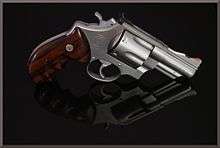
Introduced in 1978, the Smith & Wesson Model 629 is a stainless steel version of the Model 29.
The 629 model designation derives from Smith & Wesson's practice of denoting a stainless steel version of one of their already existing designs by placing a 6 in front of the model number of the original weapon. The 629 Classic variant features a full-length barrel underlug, other variants include the 629 Stealth Hunter.

| Model | Start Year | Barrel Lengths | Modifications |
|---|---|---|---|
| 629 | 1978 | ||
| 629-1 | 19xx | dropped recessed cylinders and pinned barrels | |
| 629-2 | |||
| 629-3 | |||
| 629-4 | |||
| 629-5 | Internal hammer added | ||
| 629-6 | Internal lock added |
Quiet Special Purpose Revolver
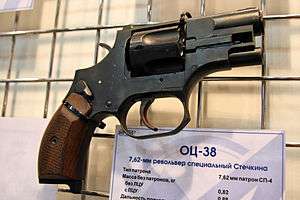
Some S&W model 29s were rebuilt by the AAI Corporation to make the Quiet Special Purpose Revolvers (QSPR). These had new, short, smoothbore barrels (35 mm / 1.375 inch), with .40" / 10mm bore, with cylinder chambers reamed to accept special QSPR ammunition which externally resembled metal-cased .410-gauge shotgun shells but internally worked as a piston to trap the gases. This special ammunition was made by AAI.[5]
This pistol was developed from 1967 to 1971 to be used by tunnel rats in the Vietnam War. The QSPR was tested on the battlefield in 1969, and an improvement and testing program ran from 1970 until 1971. At least officially it never entered service. The US withdrawal from Vietnam reduced interest in the QSPR weapon, and the program was ended about 1972.[5]
The Russian OTs-38 Stechkin silent revolver (2012) employs a similar captive piston to propel single projectiles per cartridge but in virtually every other respect it is an entirely different weapon with a host of innovative - or unique - features.
Other variants
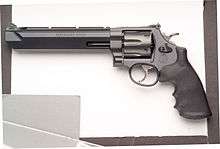
- On January 26, 2006, Smith & Wesson announced the 50th Anniversary Model 29.[6] Identical to the previous models except for the gold inlaid trademark on the side cover, the new internal lock mechanism, and a non-fluted cylinder.
- On January 1, 2007, Smith & Wesson announced the reissue of the Model 29 as an engraved model in S&W's Classics line.[7]
- The Smith & Wesson Model 629 Stealth Hunter has a 7.5" ported barrel with a full-length under lug for increased stability and recoil reduction.The barrel-cylinder gap is 0.006 in (0.1524 mm), with a ball-detent lockup between the frame and cylinder crane that provides increased strength. The entire revolver is made of a stainless steel, with a glare-reducing matte black finish. It comes with slip-resistant synthetic grips.[8]
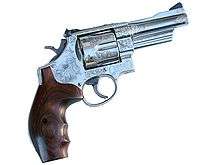
- The 329NG is a scandium-framed revolver with PVD-coated cylinder and tritium sights. It is part of the NightGuard line.[9]
Mountain Gun Variation
The Mountain Gun was introduced in 1989 as a lightweight version of the Model 29 designed to be "carried often and shot little".[10] The barrel profile is a reprise of the original design. Early version 29-4 backpacker with 2.5" barrel, (Very rare).
A Smith & Wesson Model 629 with a 3" barrel called the "Trail Boss" was produced for the distributor, RSR.[11]
In popular culture
The Model 29 was made famous by (and is still most often associated with) the fictional character "Dirty Harry" Callahan from the Dirty Harry series of films starring Clint Eastwood.
Users
 United States: Used by the Washington Police Department
United States: Used by the Washington Police Department
See also
References
- 1 2 3 John Taffin. Gun Digest Book of the .44. pp. 147–150. ISBN 0-89689-416-9.
- ↑ Hornaday, Ann (Jan 17, 1999) "Guns on film: a loaded issue ", Baltimore Sun. Retrieved 2010-04-05.
- ↑ Campbell, R. K. (December 2011). "General Purpose Handguns". The Complete Illustrated Manual of Handgun Skills. Zenith Imprint. p. 90. ISBN 978-1-61059-745-6. Retrieved 31 July 2013.
- ↑ Smith, Clint (2007). "The do-all death-ray: SDM's custom .44 Magnum". American Handgunner. 24 (4).
- 1 2 Popenker, Max R. "Smith & Wesson/ AAI Quiet Special Purpose Revolver/ QSPR/ Tunnel Revolver ", world.guns.ru. Retrieved 2010-04-05.
- ↑ Smith & Wesson press release announcing the Model 29 Anniversary Edition.
- ↑ "Smith & Wesson Classics: Model 29 Engraved" (PDF). Smith & Wesson.
- ↑ Shideler, Dan. The Official Gun Digest Book of Guns & Prices. Iola, Wisconsin: Gun Digest Books. p. 918. ISBN 9781440218903. Retrieved 16 March 2013.
- ↑ Mann, Richard Allen; Lee, Jerry (20 November 2013). The Gun Digest Book of Modern Gun Values: The Shooter's Guide to Guns 1900-Present. Iola, Wisconsin: F+W Media. p. 220. ISBN 978-1-4402-3752-2.
- ↑ Egusa, Alan (April 2010). Martial Art of the Gun: The Turnipseed Technique. Dog Ear Publishing. p. 55. ISBN 978-1-60844-226-3.
- ↑ Shideler, Dan (10 May 2011). The Gun Digest Book of Guns & Prices 2011. Iola, Wisconsin: Gun Digest Books. p. 918. ISBN 1-4402-1890-0.
External links
| Wikimedia Commons has media related to Smith & Wesson Model 29. |

